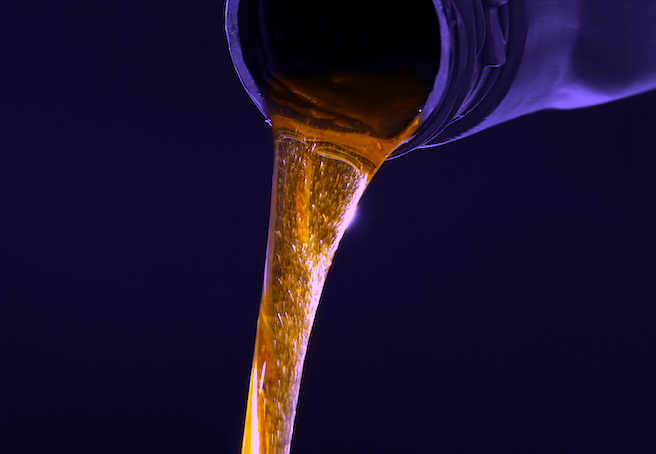Throughout their working life, lubricants are subjected to a variety of negative influences that can include load induced shear stress, thermal degradation, water contamination, aeration, wear metal catalyzing, and contamination from dirt, chemicals, and mixing with other non- compatible lubricants and fluids, These external influences can produce an array of fluid property altering effects that manifest as oxidation, polymerization, cracking hydrolysis, and fluid evaporation that can lead to a major thickening or dilution in viscosity, acid buildup, and reservoir sludge.
Lubricating oils consist of base oil and an engineered, consumable additive package designed for the oil’s intended service, e.g., gear oil, automotive engine oil, and air-tool oil, among others. The additive’s function is to combat and stave off the effects of outside influences and deliver a reasonable oil life cycle, whatever ambient conditions prevail.
Because an OEMs (original equipment manufacturers) have little or no control over the actual working and ambient conditions in which their systems operate, they make oil-change recommendations based on ideal conditions and a 40-hr. operating week. Following only OEM recommendations could mean you are changing your oil too early or too late for your particular conditions. That could translate as additional costs for meaningless oil changes or repairs. Thus, the only way to set an oil-change schedule is to test and trend the lubricantl regularly to determine when and how it degrades. Doing so can help an organization establish a fiscally-responsible, condition-based approach toward oil-life-cycle management.
When attempting to determine an oil’s condition and remaining life expectancy, we must analyze its fluid properties to establish the presence of an additive package, its depletion rate, and oxidization presence/effect. To establish if and when an oil change is warranted, the lubricant is tested in numerous ways against a virgin-oil baseline with two primary measured indicators leading the decision-making process: 1) major changes (up or down) in an oil’s viscosity measure; and 2) increase in an oil’s acidity AN (Acid Number) measure.
Regarding Viscosity Testing
When looking at the Viscosity rating of new oil, typically the viscosity is measured in Centistokes (cSt), which is the oil’s Kinematic Viscosity rating that depicts its measured resistance to flow and shear caused by the force of gravity. As the oil thickens or dilutes over time, its specific gravity (SG) changes and can result in testing errors when using a gravity based viscosity test. A more consistent measurement is achieved by checking for the Absolute Viscosity rating that depicts oil’s resistance to flow and shear through the measurement of its internal friction. Because absolute viscosity is measured by multiplying the kinematic viscosity by the actual specific gravity it provides an error free and accurate trending measurement, therefore making it the measurement of choice for most oil labs; you will know the difference in the two viscosity scales as absolute viscosity is measured in Centipoise (cPs), as opposed to Centistokes (cSt).
Due to the large variables encountered in oil use, it is preferred to work with a laboratory that has experience is setting up caution and critical limits for your industry type. Typically most labs will start off with a clearly defined set of viscosity working limits of -10% CL (Critical Lower), -5% CaL (Caution Lower), +5% CaU (Caution Upper), and +10% CU (Critical Upper) for Industrial oils. In more severe environments, the CaU and CU limits can be reduced to +4% and +8% respectively. For oils with Viscosity Improvers the lower limits are usually doubled.
Regarding Acidity Testing
The AN (Acid Number) is a measurement of the acid concentration in the oil—not the acid strength, and is greatly affected by the presence of water within the oil. Most virgin oil will starts with an acid number less than 2.
Setting limits for oil acidity is not as easy as viscosity as the caution and critical limits are set according to the type of additive package used in the oil. Most standard mineral oils are considered corrosive of measured greater than AN 4, whereas an AW (Anti-Wear) or R & O (Rust and Oxidation) inhibited oils are considered critical well below AN 3. Working with your oil supplier’s engineering department and/or a reputable oil lab with experience in your industry is the best way to set up meaningful acceptable limits for your environment.
As in any trending analysis the rate of change is arguably more important than the actual change number as it signifies a specific change event has taken place that likely requires immediate investigation.
Good luck with your future oil changes.TRR
(Editor’s Note: For comprehensive information on lubricant analysis, consider the book Practical Lubrication for Industrial Facilities, 3rd Edition, co-authored by Heinz Bloch and Ken Bannister (ISBN 9781138626799).
ABOUT THE AUTHOR
Ken Bannister has 40+ years of experience in the RAM industry. For the past 30, he’s been a Managing Partner and Principal Asset Management Consultant with Engtech industries Inc., where he has specialized in helping clients implement best-practice asset-management programs worldwide. A founding member and past director of the Plant Engineering and Maintenance Association of Canada, he is the author of several books, including three on lubrication, one on predictive maintenance, and one on energy reduction strategies, and is currently writing one on planning and scheduling. Contact him directly at 519-469-9173 or kbannister@theramreview.com.
Tags: lubrication, industrial lubricants, oil analysis, reliability, availability, maintenance, RAM



